Find Your Perfect School
The concept of a need blind university is a deceivingly simple proposition, however, the results of need-blind policies are far-reaching and might surprise you. But first things first–a need blind institution refers to the title of a school that adheres to an admission policy that intentionally excludes any consideration of an applicant’s financial circumstances. The focus implied by this exclusion is a focus on the academic and professional merit of each individual student independent of any financial influence.
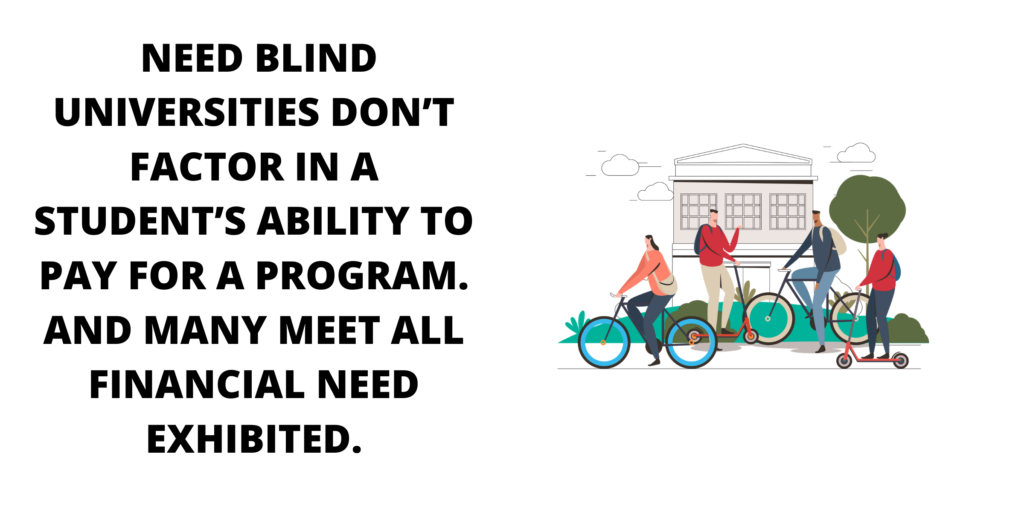
What is the allure of a need-blind institution for prospective students? The most attractive aspect of need-blind application policies is that many of them provide generous no-loan policies and will meet each student’s individual financial needs. This ensures that a student’s application will not be rejected based on a high level of financial need, and conversely that a well-off student will not be accepted based on their lack of financial need.
It should be mentioned, however, that only about half of need-blind institutions offer the above-mentioned full financial coverage. Unfortunately, around half of need-blind institutions partially admit students in an ‘admit-deny’ format–where students are tentatively accepted but will not be provided with full financial coverage in which case the student is essentially rejected if they cannot come up with the necessary funding.
But don’t worry–we will provide some additional information on how to quickly differentiate fully-funding need-blind universities from those that provide only partial coverage. But before we delve into that, it’s important to answer one question.
Why Choose a Need-Blind University over a Traditional?
One of the most notable strengths of a need-blind university is that it represents a bold commitment to students. For a university to admit students without any prior knowledge of their financial backgrounds, a fully-funding need-blind institution is essentially committing to cover all or most of financial needs (in the most severe cases of financial need).

For a university to back up this commitment, a robust channel of funding is required and many of these schools end up dipping into their endowments far more regularly than schools that do not participate in need-blind admission policies.
In other words, need-blind universities put the money where their mouths are–they take financial responsibility for admitting only the best students. This sort of student-first commitment is reassuring in a time where predatory practices are becoming more and more pervasive in the higher education industry.
And if you have ever taken a look at some of the more financially rich universities, an assessment of their titanic endowments can make you wonder–why aren’t they investing more in their students and programs? Need-blind universities do just that.
So let’s just sum up some of the best reasons to consider a need-blind university over a traditional university:
- Need-blind universities provide a foundation of a meritocracy
- Students can enjoy a shared focus on individual talent and achievement
- As opposed to a school more focused on one’s financial background
- As such, need-blind universities bring students from diverse backgrounds together
- A need-blind university confers individualistic achievement to future employers
- Need-blind admissions have only been approved for the next two years, so there is a small chance that these policies will not be renewed, or at least altered
Need Blind Versus Need Aware Universities
As mentioned in the introduction, only about half of need blind universities truly exclude consideration of a student’s socioeconomic status from the admissions process, while the other half end up considering it at some point because they are unable or unwilling to fully cover students’ expenses. The group of universities who consider socioeconomic status at some point during the admissions process is referred to as ‘need aware’ universities.
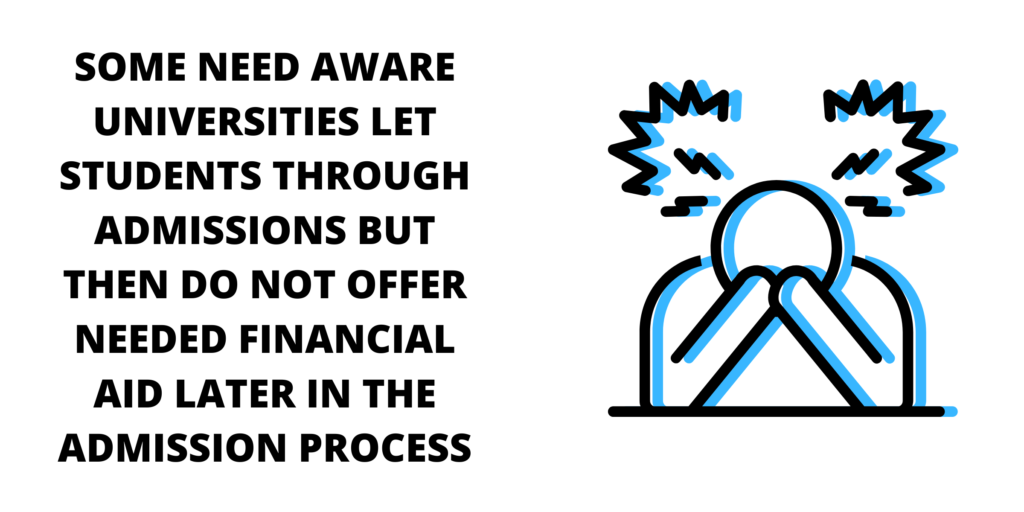
Need aware universities will not necessarily reject students based on their financial needs, and they will not necessarily consider an applicant’s socioeconomic background a major concern. But a need aware university will be guaranteed to at least review a student’s socioeconomic status at some point during the admissions process.
The extent to which a student’s socioeconomic is weighted during the admissions process will depend on the policies and value structure of each individual school. It can be difficult to navigate and fully understand which need aware universities value meritocracy over socioeconomic weighted valuations–so let’s dive into which schools are completely need-blind.
Some universities will exclude considerations of a students’ financial background during the admissions process only to reject severe cases of financial need later. Other programs will offer need-blind admissions and full financial coverage to only some students. The list of schools that offer need blind and full financial coverage to students is a much smaller one, and smaller still for international students.
Your Complete List of Need Blind Universities with Full Financial Coverage
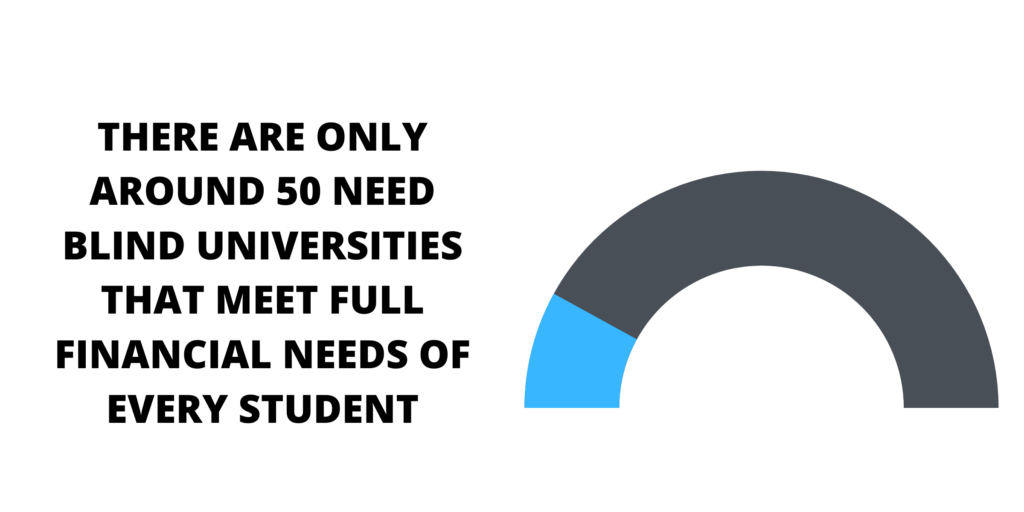
The need blind universities listed below do not consider an applicant’s socioeconomic status at any point during the admissions process. The following universities are true representatives of the ‘need blind’ admission policy and will be safe bets for any student looking for college admissions that will not evaluate financial need as part of the admissions process–however students are not guaranteed to have financial needs met.
- Amherst College
- Barnard College
- Boston College
- Bowdoin College
- Brown University
- California Institute of Technology (Caltech)
- Claremont McKenna College
- Columbia University
- Cooper Union for the Advancement of Science and Art
- Cornell University
- Dartmouth College
- Davidson College
- Duke University
- Emory University
- Franklin W. Olin College of Engineering
- Georgetown University
- Grinnell College
- Hamilton College
- Harvard University
- Harvey Mudd College
- Haverford College
- Johns Hopkins University
- Kenyon College
- Lehigh University
- Massachusetts Institute of Technology (MIT)
- Middlebury College
- Northeastern University
- Northwestern University
- Pomona College
- Princeton University
- Rice University
- Salem College
- Soka University of America
- St. Olaf College
- Stanford University
- Swarthmore College
- Thomas Aquinas College
- Trinity University
- Tufts University
- University of Chicago
- University of North Carolina at Chapel Hill
- University of Notre Dame
- University of Pennsylvania
- University of Richmond
- University of Rochester
- University of Southern California (USC)
- University of Virginia
- Vanderbilt University
- Vassar College
- Wellesley College
- Wesleyan University
- Williams College
- Yale University
Universities that offer both need blind admissions and full financial coverage are true exemplars of the need-blind model. Because students of severe financial need will not be turned away further down the admissions process. Here is a list of universities that fall within this category of offering both need-blind admission and meet students’ total financial coverage (with some noted clarifications for specific groups of students):
- Antioch College (for students who qualify for the Pell Grant have the full need met)
- Babson College (offers need-blind admissions for Canadian students, too)
- Barnard College (only need-aware for transfer students)
- Berea College (tuition-free for all students through need-based aid, family EFC, and work-study programs)
- Boston College
- Bowdoin College (need-aware policies for transfer students)
- Brandeis University (need-aware policies for transfer and waitlisted students)
- Brown University (need-aware policies for transfer students)
- California Institute of Technology
- Carnegie Mellon University
- Claremont McKenna College
- College of William & Mary ( in-state students have the full need met; out-of-state students get only a maximum of 25% cost covered)
- Columbia University
- Cornell University
- Dartmouth College
- Davidson College
- Denison University
- Duke University
- Elon University (for Odyssey Scholars only)
- Emory University (no full need for international students)
- Georgia Institute of Technology (mostly only low-income in-state students selected for the Godbold Family Foundation Scholarship will have 100% of financial need covered)
- Georgetown University
- Grinnell College
- Hamilton College (need-aware policies for transfer students)
- Harvey Mudd College
- Johns Hopkins University
- Lehigh University (need-aware policies for waitlisted students)
- List College
- Middlebury College (need-aware policies for transfer students and wait-listed students)
- Northwestern University (does not offer financial aid to international transfer students)
- Olin College
- Pomona College
- Purdue University (financial coverage for 21st Century Scholars who are below a set income level only)
- Rice University
- Soka University of America
- Stanford University
- Swarthmore College
- Tulane University (only in-state first-year students below an income threshold have the full financial coverage)
- University of California, Los Angeles (only in-state students have the full need met; out-of-state students don’t receive financial aid)
- University of Chicago
- University of Delaware (only in-state students have the full need met)[41]
- University of Florida (only in-state students have the full need met)[42]
- University of Michigan (need-blind for in-state students only; only in-state students have the full need met)
- University of North Carolina at Chapel Hill
- University of Notre Dame
- University of Pennsylvania (need-blind policies for Mexican and Canadian students as well)
- University of Richmond (need-aware policies for transfer students)
- University of Southern California
- University of Virginia
- University of Wisconsin – Madison (only for in-state students who qualify for the Pell Grant have their full financial need met)
- Vanderbilt University (need-aware policies for waitlisted students)
- Vassar College (need-aware policies for transfer students)
- Wake Forest University
- Wellesley College
- Williams College
Some universities offer a combination of full need-blind admissions with partial financial coverage. Here is a list of universities in this category with some notes on the extent of financial coverage offered:
- Baylor University (65% of need on average)
- Bucknell University (91% of need on average)[88][89]
- Cooper Union (all admitted students receive a half-tuition scholarship)
- Fordham University
- Hampshire College
- Hillsdale College
- Ithaca College
- New York University (60% of need on average)
- Saint Louis University
- Santa Clara University
- Southern Methodist University (85% of need on average)
- St. John’s College
- St. John’s University
- St. Lawrence University
- Syracuse University (93% of need on average)
- Texas Christian University (66% of need on average)
- Juilliard School
- University of San Diego (71% of need on average)
Unfortunately, as an international student finding a university that offers both true ‘need-blind’ admissions and full financial coverage is notoriously difficult. In fact, there are reportedly only seven who offer both programs to the fullest extent of their definitions to students outside of the United States:
- Amherst College
- Curtis Institute of Music
- Harvard University
- Massachusetts Institute of Technology
- Minerva Schools at KGI
- Princeton University
- Yale University
The Need Blind Admissions Process
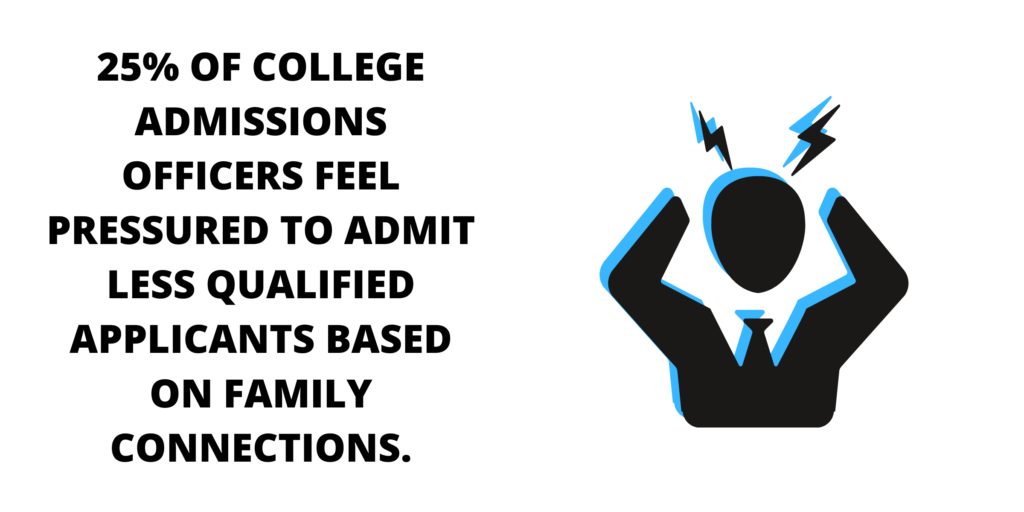
What do you need to know before applying to a need-blind university? Don’t worry, we’ve got you covered. For all intents and purposes, a need blind university’s admission process will mirror the process of a need-aware admissions process–except of course for the lack of consideration given to financial considerations.
A Kaplan Survey from several years ago reported that around 25% of admissions officers felt pressured to admit less qualified applicants based on their family connections. While there is no guarantee that this problem won’t exist at need-blind universities to some extent, family pressures will carry much less weight if there is no consideration given to students’ socioeconomic status. Admissions officers will be more likely to have the freedom to focus more intently on qualified candidates.
So with this in mind, students applying to a need blind university will want to pay special attention to the traditional elements of the application package:
- Grades / Academic Transcript
- Letters of Recommendation
- Extracurriculars
- ACT Scores
- SAT Scores
- Application Essay
It should also be noted that some need blind universities will only meet the full demonstrated need of US applicants, and will apply different admissions criteria to international students. So if you are scouting colleges from outside the US, be sure to pay careful attention to this distinction.
The Financial Environment of Need Blind Universities
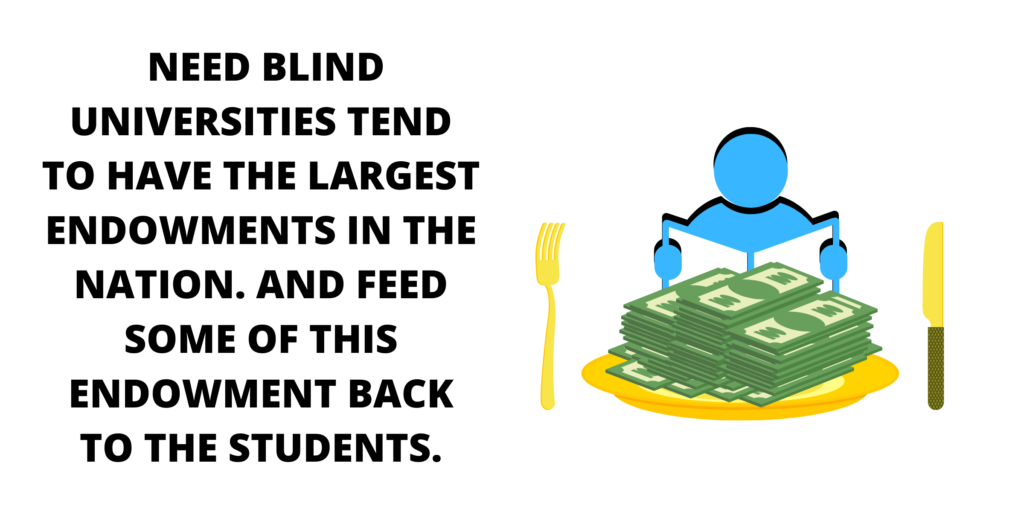
Anyone familiar with the endowment structure of the largest American universities will know just how much money many universities have behind them. According to an evaluation of the market value of endowment funds, here are five of the richest American universities as of 2019:
- Harvard University ——————- $39,430,000,000
- The University of Texas System — $30,960,000,000
- Yale University ————————- $30,310,000,000
- Stanford University ——————- $27,700,000,000
- Princeton University —————— $26,120,000,000
All of these listed universities (only some within the University of Texas System) are need-blind universities that will meet the full demonstrated need of applicants without previous consideration of socioeconomic status during the admissions process. And this is a good thing because with such astronomical endowments these schools can certainly afford to assist in the tuitions of their students.
But it does beg the question–with tens of billions in endowment, should they be doing more? Most students will attend need-blind universities with much more modest financial profiles, so how do these smaller schools offer need-blind application policies? After all, students will not want to attend a university that is at risk of bankruptcy.
This is why there is such a discrepancy between specific approaches to meeting the full demonstrated financial needs of students. Some universities will meet students’ financial needs entirely through grants and scholarships, while others will require that students pay back loans through work-study opportunities limited entirely to on-campus programs.
So in order for students to find the right need-blind university, be sure to read the fine print of the individual school’s financial need policies. Unfortunately, there is just too much nuance and variation between these approaches for us to provide a boilerplate template for you to consider; however, for the most part, need blind universities will cover financial need through grants and scholarships, or by other means (student loans, work-study programs, etc.).
So for easy screening, universities that cover financial needs through the former will be your safest bet. After all, a need blind university really starts to lose its allure if admitted students are forced to split their energies between full-time schoolwork and demanding work-study positions.
How to Evaluate a Need Blind University’s Financial Aid Policies

While some universities hide predatory financial aid policies behind alluring program terminology, other universities genuinely structure financial aid packages to benefit students. Students will need to dig hard in order to evaluate a university’s work-study and financial aid programs.
Some work-study programs are designed to accommodate students’ demanding schoolwork and will lean into the individual strengths of students. For instance, some programs may offer work-study opportunities for research jobs within a student’s chosen area of study–which could work to simultaneously build professional experience while contributing to the student’s financial aid. As mentioned above though, other work-study programs will put students in tenuous positions that will be counterproductive in balancing work and academics.
For students to get a realistic picture of what to expect, it can be tremendously beneficial to take the time to investigate the experiences of previous students. And be sure to interview more than just a few; far too many students have run with one positive review only to find that their experience could not have been more drastically different.
So with that in mind, let’s go over some tips for evaluating a university’s financial aid and work-study packages:
- Speak to current students that are specifically within your desired area of study or major
- Speak to students who have demonstrated a level of financial need similar to yours
- Speak to students who have much less demonstrated need–and compare experiences to students of severe need
- Ask students if they have noticed work study programs cause any academic problems for students
- Ask students if they are aware of any changes to financial aid programs or work study programs (sometimes these change year by year)
- Speak to a number of students, more than you think you need to
- Speak to alumni who might be able to tell you how programs have changed over the years–this can help you identify if changes are trending in a certain direction
As you can tell, this is quite a lot of investigative work. You might find that it is necessary to dedicate a day to fulfilling the above list. And if you can begin making arrangements before you visit the university’s campus that would be ideal. To this end, if you have any family, friends, or connections on campus, you could see if they would be able to assist you in finding the right students to speak with.
Major Takeaways for Choosing the Right Need Blind University
One of the first major points to make is that choosing the right university will depend on having a strong understanding of your unique situation and needs. You might need to do some research to find out exactly what level of financial need your situation requires. With this in mind, you might find that need-blind universities that only offer partial financial coverage will not be a problem for you.
And likewise, you might decide that a need-aware admissions process will not negatively impact your chances for admission. There are so many nuanced iterations of the need-blind university model that there are options available that will match any student’s desired outcome. So the primary questions come down to these two:
- How much does need blind admission matter to you?
- How much does full financial coverage matter to you?
Answering these two questions will form the foundation for narrowing down your list of universities to select from. The next major issue will arise if you discover that the listed available schools do not meet your other criteria for evaluating a university–be it for its location, available options, or for other reasons.
Like any prospective student, you will want to strike a balance of giving and taking by relaxing on some of your desires in order to prioritize the fulfillment of your most important objectives. If this sounds like an overwhelming endeavor, then be sure to take advantage of the resources made available to you as a prospective student in the near future.
A high school guidance counselor will be able to help you navigate these endeavors, and likewise, many other resources on this site will help you arrive at the best decision that matches your unique academic background and career aspirations. Good luck!
For additional information, see: Is it Better to Attend a For-Profit or Non-Profit College or University?
